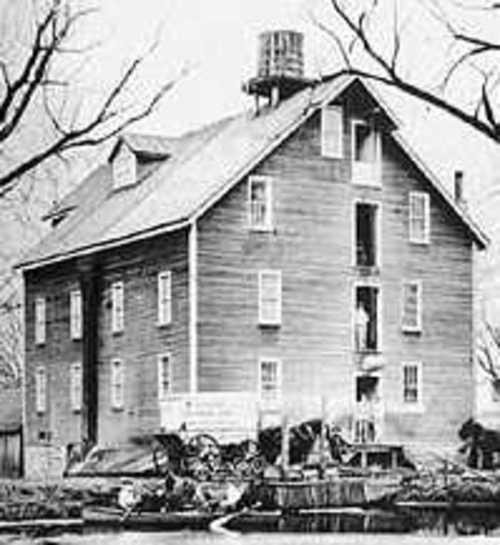Haines Mill
 In 1773, Issac Haines and others petitioned the Assembly to permit the building of a dam to power a gristmill and a sawmill. The venture--Haines Mill--was a three-way partnership between Johnathan Haines, his son Issac and Samuel Philips. It was said that the workmen building the mill could hear the roar of the cannon during the battle at Redbank (now National Park) near Gloucester.
In 1773, Issac Haines and others petitioned the Assembly to permit the building of a dam to power a gristmill and a sawmill. The venture--Haines Mill--was a three-way partnership between Johnathan Haines, his son Issac and Samuel Philips. It was said that the workmen building the mill could hear the roar of the cannon during the battle at Redbank (now National Park) near Gloucester. The brick house across the millrace (referred to as the miller's house) was built by Nehemiah Haines about 1785 for his son Charles. Around 1830 Charles enlarged the mill from its original single story with loft to a three-story structure double the original size. The blacksmith shop and small barn were built about the same time.
William S. Kirby bought the mill complex in 1877, and again changes were made--including the name. In the next few years, at Kirby's Mill, the roof was lifted, adding a fourth floor and later a Victorian gable in the front. Another major change was the removal of the waterwheel and the installation of water turbines.
The property passed on in the Kirby family to Albert Kirby and his brother Charles, who again enlarged the complex. They built and addition on the east side of the gristmill and enlarged the storage barn across the road, complete with gable to match the main building.
It was during this era that the complex was at the height of its productivity. A gas plant was installed, supplying gas light to all the buildings on the road. You can still see the pipes and jets in the main building. The building to the east, next to the dam, was a cider mill in the fall, a carding mill in the spring, and was used to produce cedar shingles in off periods.
The sawmill was kept busy sawing logs for shipment not only to local boardyards but also to Philadelphia and Baltimore buyers. The gristmill was producing wheat flour, buckwheat and rye flour, along with cornmeal and chicken feed. A lot of the grain was local. However, the local farmers could not grow the necessary quantity, so some grain was purchased through brokers. The flour produced here was much in demand by bakeries along the east coast.
By World War I more modern machinery has replaced the millstones...although they were never removed and are in excellent condition. The mill stopped producing flour in the 1920's and concentrated more on livestock feed. The sawmill finally shout down because of the lack of local timber, and the blacksmith and wheelwright shops closed down with the coming of the automobile. The gristmill operated under water power until 1962. It was then converted to electricity due to low water and mechanical problems.
It was still in partial operation when the Medford Historical Society purchased it from the Kirby brothers in 1969. This mill was the last operating commercial mill in the state of New Jersey, and is located at the intersection of Fostertown Road and (#275) Church Road, in Medford.
Kirby's Mill was declared a State Historic Site in July of 1971, and was placed on the National Register of Historic Sites in September of 1972. The Medford Historical Society continues to work to restore and maintain the complex to enable future generations to wander back into the past and see part of early Americana.
Aside from being a favorite scene for artists and photographers to capture, the Historical Society holds a number of events at the mill throughout the year including “Country Day,” quilt shows, and the always well-attended Apple Festival in the fall, at which you can walk the property and browse the artistry and craftsmanship of local artisans, and best of all, find many things apple to eat!!
For additional information, contact the Medford Historical Society at P.O. Box 362, Medford, NJ 08055.
© SouthJersey.com 2015. All rights reserved. This article or parts thereof may not be reprinted or reproduced by any other party without the express written consent of SouthJersey.com. For more information, please call 856-797-9910.
For more South Jersey History, visit our South Jersey History page.
advertisement

Author: Editorial Staff, SouthJersey.com
Archives
A TALE OF THREE WEDDINGS
Timber Creek’s Leary heads to Illinois
The Berlin Cemetery
A Southern Mansion
Fire on the Morro Castle
Pine Barrens Fire of 1936
The Legacy of Hezekiah Bradley Smith
The Powhatan Renape Indians
The `Park-In` Movie Theatre
Glassboro: A History
New Jersey Natives: The Lenni-Lenape
Burlington County Prison Museum
Parvin State Park
John Henry `Pop` Lloyd
Jersey Devil: Fact or Fiction?
More...







